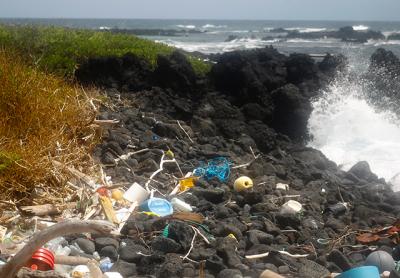Isabela, and What They Found There

Last fall, Billy Strong and Dell Cullum would reveal few details of the unique project they were planning, raising almost as many questions as answers. Despite scant details, Mr. Strong, an environmental activist known as the Green Explorer, and Mr. Cullum, a photographer, wildlife-removal specialist, and tireless crusader against litter, seemed an ideal partnership. The East Hampton residents were equally passionate about the environment, and their plan was ambitious.
Almost a year later, their labor has borne fruit. “Isabela: A Green Explorer Expedition” documents their winter trip to and around the largest island of the Galapagos, 563 miles west of Ecuador in the Pacific Ocean. There, Mr. Cullum filmed as Mr. Strong, who has traveled the world imparting the message that “Your environment is you, and how you treat that environment is how you treat yourself,” found and made art from the multiple trash and debris fields they found on the island’s eastern shore.
In the process, the men communed with creatures large and small, from cormorants to orcas, from seals to sharks. They also encountered a few humans, one of whom proved more dangerous than the apex predators of the sea.
“Isabela: A Green Explorer Expedition,” Mr. Cullum’s first full-length documentary, will be shown on Aug. 21 at 4 p.m. at the Mulford Farm Gallery in East Hampton, accompanying a show of Mr. Strong’s island-trash sculptures.
Mr. Strong had been to Isabela the previous year, meeting and explaining his idea to a local man named Sebastian. “He’s like the Dell Cullum of the Galapagos,” Mr. Strong said of the anti-litter activist. Sebastian led him to the last wooden fishing boat in the Galapagos, which was run down. “I said, ‘Let me put money toward this so we can restore the boat and get it ready for this journey.’ When I came back with Dell, the boat was ready.”
Just after the New Year, the 14-day expedition to circumnavigate the island began. Immediately, Mr. Strong and Mr. Cullum, accompanied by the boat’s captain and two-man crew, were immersed in unforgiving but indescribable beauty. They dropped anchor and went to shore at several points.
“I was overwhelmed by the beauty of the landscape,” Mr. Strong said. “Finding these debris fields was a little depressing, but it’s what I love to do, I get kind of excited when I find a lot of stuff — that’s my material. Even though they were extremely rough conditions, I was in my zone.”
Within hours of finding a field of trash, much of it brightly colored plastic discarded from ships, he had conceived and assembled large sculptures, most human or animal in form. They were mounted and left behind as a messenger of sorts, “so people can know there are debris fields and through their curiosity see what’s going on,” he said.
The heat was stultifying, and dehydration an ever-present threat. The seas were often rough, and the old fishing boat broke down several times. “I’ve known Billy for a long time, and always respected him as a person and an artist,” Mr. Cullum said. “But because of this trip, I respect his art so much more, and really started to see that unique individual doing what I call ‘extreme art,’ in extreme locations, under extreme conditions, building art from debris. To go to these locations and do it under these conditions, that’s different. It was really, really difficult, mentally and physically, but for Billy it was a mission. You could see it.”
Mr. Strong and Mr. Cullum would often jump off the boat and immerse themselves in the sea, the latter capturing its stunning beauty on film. They were not alone. The first orca sighting was quickly followed by two much larger orcas. “We had already seen sharks, and I was paranoid,” Mr. Cullum said. “They were telling me, ‘These are Galapagos sharks, there’s so much food in the water, there’s nothing to worry about.’ I was, like, ‘Famous last words.’ After those orcas showed up, I lost my fear of sharks. However, I was scared to death of orcas, which we saw the whole trip — we must have seen a dozen. There were times when everyone would jump in the water. Then I would do it. I would never have done it anywhere else, but I thought, if this is my time, what better place than Galapagos?”
The men carried as much trash as they could from the island to the boat; its hold was quickly filled. “There’s so much trash in the oceans that every island is getting affected,” Mr. Strong says in the film. “The most pristine place in the world, and there’s trash all over it.” As he works, he makes reference to the town he and Mr. Cullum call home. “It’s the same way where we live,” he says. “We live in paradise too, and people trash it. They come out there and do whatever they want, trash it. No respect.”
Mr. Strong has traveled far and wide, from Costa Rica to India, finding pollution everywhere and spreading the message of environmental consciousness and care to all he encounters, particularly children. “Everywhere I’ve been in the world, it’s the same thing,” he said. “Through education, I’m trying to show people we can change it, a little at a time.”
Mr. Cullum also intends to spread the message worldwide, showing “Isabela: A Green Explorer Expedition” via LTV, in schools and libraries, and on YouTube.
